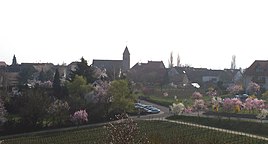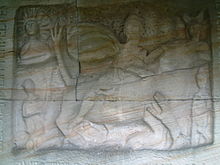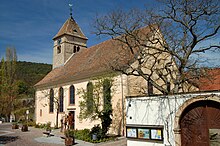Gimmeldingen
|
Gimmeldingen
City of Neustadt an der Weinstrasse
|
|
|---|---|
| Coordinates: 49 ° 22 ′ 35 ″ N , 8 ° 9 ′ 8 ″ E | |
| Height : | 174 m above sea level NHN |
| Area : | 7.17 km² |
| Residents : | 2529 (Jan 1, 2009) |
| Population density : | 353 inhabitants / km² |
| Incorporation : | 7th June 1969 |
| Postal code : | 67435 |
| Area code : | 06321 |
|
Gimmeldingen (red) within the district of Neustadt
|
|
|
Silhouette of Gimmeldingen from the Neuberg
|
|
Gimmeldingen , which as a winegrowing village had had the addition of "on the Weinstrasse" since 1935, was incorporated into the district of Neustadt an der Weinstrasse ( Rhineland-Palatinate ) in 1969 as a district 3 km to the south . Today it has around 2500 inhabitants.
geography
location
The town center is grouped at a height of a good 150 m above sea level. NHN around the Protestant parish church on a hill on the German Wine Route in the Vorderpfalz on the western edge of the Upper Rhine Plain . Gimmeldingen has spread into the Mußbach floodplain south of the hill - called Gimmeldinger Tal - as well as to the southwest and northwest into the slopes of the Haardt , the eastern edge of the Palatinate Forest .
Neighboring places
Neighboring towns in the south are the core town of Neustadt and in the southwest, north and east the Neustadt districts of Haardt , Königsbach and Mußbach . To the west, within the Palatinate Forest, borders the district of Lindenberg .
Gimmeldingen grew together with the neighboring town of Mußbach to the east as early as the 19th century and shared a 500 m street with it, which formed an unusual border: The houses on the north side belonged to Gimmeldingen as "Mußbacher Straße", and on the south side as " Gimmeldinger Straße ”to Mußbach. The street area lay entirely on the district of Mußbach, which also had to maintain the street. Since the simultaneous incorporation of both places after Neustadt, the common vein has been called “Kurpfalzstraße”, but the invisible municipal boundaries still exist.
Elevations and waters
To the west of the village rises the Weinbiet ( 554 m ) with its east runner Nebelberg ( 319 m ), to the east there is a foothill of the low mountain range, the 194 m high Kieselberg .
The nearly 12 km long Mußbach takes Gimmeldingens forest district the water of Loogquelle and the Neumühlquelle and then flows from west to east through the residential areas of Gimmeldingen and Mußbach. 2 km south-east of the latter district, it flows into the Rehbach , the northern branch of the Speyerbach .
climate
The location of the place in the Vorderpfalz , which is part of the Upper Rhine Plain surrounded by low mountain ranges, results in a mild climate. Average annual temperatures are around 10 ° C, 0 ° C in winter and 20 ° C in summer. In the lee of the Weinbiet on the eastern edge of the Palatinate Forest, the average annual precipitation is a maximum of 500 mm; This means that Gimmeldingen is located in one of the areas with the least rainfall in Germany.
history
In the Middle Ages , the small village of Lobloch , which became part of Gimmeldingen in 1751, lay in the south-east of the Mußbach valley . In the meantime it has merged so closely with the main town that an optical separation is no longer possible. Until the end of the 18th century the place belonged to the Electoral Palatinate .
From 1798 to 1814, when the Palatinate was part of the French Republic (until 1804) and then the Napoleonic Empire during the coalition wars , Gimmeldingen and Lobloch - as they were called at the time - were incorporated into the canton of Neustadt (Donnersberg) and had their own mairie . In 1815 the place Austria was added. Just one year later, like the entire Bavarian Palatinate, he moved to the Kingdom of Bavaria . From 1817 to 1862 the community belonged to the Landkommissariat Neustadt ; from this the district office of Neustadt emerged. In 1860 Gimmeldingen received the official double name Gimmeldingen-Lobloch from the Kingdom of Bavaria ,
From 1939 the community was part of the district of Neustadt an der Weinstrasse . After the Second World War , the place within the French occupation zone became part of the administrative district of Palatinate in the then newly formed state of Rhineland-Palatinate . On November 27, 1952, the community name was changed to Gimmeldingen . The name of the former village of Lobloch is only included in the names of Loblocher Strasse , Lobloch Castle and a local wine festival (see section Festivals ). In the course of the first Rhineland-Palatinate administrative reform , Gimmeldingen was incorporated into the independent city of Neustadt an der Weinstrasse on June 7, 1969.
population
Population development
In 1815 the place had a total of 1168 inhabitants. Gimmeldingen is becoming more and more important as a residential suburb of Neustadt. At the time of incorporation in 1969 it had almost 2000 inhabitants, due to the expansion of residential development, especially in the south and north-western slopes, the number has meanwhile increased to over 2,600. In June 2011 Gimmeldingen had 2,643, in January 2012 then 2,426 inhabitants.
religion
The Nikolauskirche was built on the area of a Mithras shrine from the Roman times . In 325 AD the Roman Materninius Faustinus had the temple built in honor of the god Mithras, who was taken over from the Persian Empire . During construction work in 1926, the foundation walls and a stone relief image were found. Its original is in the Historical Museum of the Palatinate in Speyer , a replica is embedded in a boundary wall a piece to the left of the church entrance.
As early as 1472, a religious brotherhood of winegrowers in honor of Our Lady was documented in Gimmeldingen . It was canonically recognized on January 10, 1472 by the vicar general Peter vom Stein from Speyer and given indulgences for its members.
In Hildenbrandseck Monastery , located in the Gimmeldinger district on the southeastern outskirts of Königsbach, the motherhouse of the Catholic Hildegardis sisters was located from 1956 to 2004 . Because there was no new generation of novices , the property was sold to the operating company of a clinic for plastic surgery .
politics
coat of arms
| Blazon : "Split by black and silver, on the right a left-facing red armored, tongued and crowned golden lion, on the left a black rust." | |
Local advisory board
A local district was formed for the Gimmeldingen district . The local council has 13 members, the chair of the local council is chaired by the directly elected mayor.
For the composition of the local advisory board, see the results of the local elections in Neustadt an der Weinstrasse .
Mayor
The head of the village is Claudia Albrecht ( CDU ), who was the only applicant in 2019 and received 66.4% of the votes.
Sights and culture
Cultural monuments
The town center and Kurpfalzstrasse are each designated as monument zones. In addition, there are numerous individual objects that are protected as cultural monuments :
Churches
The Protestant parish church in the center of the village was built before 1160 from a barely 10 m small hall church . In the last quarter of the 12th century it was enlarged and a Romanesque tower was added, which today has three bells. In 1723 a baroque hall building was added, which was expanded to its present size in 1803. It was originally dedicated to the martyr Laurentius of Rome , whose symbol of torture, the rust, is also depicted on the local coat of arms.
The small high Gothic St. Nicholas Church with its even older Romanesque tower is located on the slope between the parallel streets Loblocher Straße (entrance side, below) and Kurpfalzstraße (above). It was once the Catholic church in Lobloch. The church was abandoned to decay from around 1700, from 1956 onwards, consecrated again in 1957 and assigned to the Mußbach parish as a Catholic branch church. The three windows in the altar area consist of impressive stained glass mosaics by the glass painter Erhardt Klonk .
Old castle
The old castle on the Kieselberg on the eastern edge of the former town center dates from the Salier period and was built around the year 1100. The modest foundation and wall remains only still leave the basic features of the system with tower and Palas guess.
Heidenburg
The Heidenburg is the ruin of a ring wall, which is located southwest of the Gimmeldinger settlement area in the Palatinate Forest and probably from the 9th / 10th. Century.
King Ludwig Pavilion
On the Neuberg, a hill in the northwest of Gimmeldingen towards Königsbach, a large sandstone with the inscription “The garden of Germany - the blooming Palatinate! Ludwig I. 1856 “ the frequent visits of King Ludwig I of Bavaria , who enjoyed the view over the Rhine plain from an octagonal garden shed. The garden shed is now called the King Ludwig Pavilion .
Lobloch locks
The Estelmann winery, in front of Hick (Kurpfalzstrasse 76) was built, presumably towards the end of the 19th century, in the form of a small castle , to which the (non-historical) name Loblocher Schlössel has since been added. Its squat square tower covered with slate rises up from the side of the main building, which also has a rather large roof turret. A wine bar of the same name is operated in the former stables , the large paved inner courtyard of the winery is surrounded by greenery and is also used for gastronomic purposes.
White House
Diagonally opposite you are already in the district of Mußbach. There (Kurpfalzstrasse 77) is the White House, which is also worth seeing .
nature
There are a total of three natural monuments on site , including the Loosenbrunnen . In addition, the Haardtrand - Berggewanne nature reserve extends over Gimmeldingen.
Festivals
Because of the close ties with Mußbach, many events are held together with the neighboring town . Festivals originating in Gimmeldingen are:
Gimmeldinger Almond Blossom Festival
From March onwards, the early almond blossom in Gimmeldingen plunges into a pale pink sea of flowers. The almond blossom festival , at which the almond blossom queen and almond blossom princess are chosen, attracts many people every year who want to celebrate the awakening of nature after winter. As one of the earliest events of the year, the Almond Blossom Festival is now one of the largest wine festivals in the region. The exact date (March / beginning of April) depends on the onset of almond blossom and can therefore shift from year to year.
More festivals
Every year at Pentecost, the Lobloch wine tenth is celebrated. The date for the Weinkerwe is the third weekend in August. The Gimmeldinger Herbst takes place in October .
Sports
To the west of the place where the Mußbach leaves the mountains are the soccer field and the old sports hall of the TV Gimmeldingen. The sports center at Hildenbrandseck , north of Gimmeldingen, is used together with the neighboring town of Königsbach .
Economy and Infrastructure
economy
Agriculture
The main branch of agriculture is viticulture , as the favorable climatic conditions enable the production of high quality wines . The most famous location is the Gimmeldinger Meerspinne , which has meanwhile been upgraded to a major location. Although a garden spider was introduced as a symbol by marketing people , the name has nothing to do with the arthropod . Rather, it means, pronounced "Määrspänn" in the local dialect , Mehrspänn and is derived from Mehrspännig ; because the slope of the hill on which the vineyards of the original individual location are located, previously made a second draft horse necessary when the wagon was loaded. Other well-known Gimmeldinger vineyards are z. B. Almond orchards and Biengarten . Besides grapes ripen in the open field and almonds , chestnuts , figs and citrus fruits , asparagus is also grown. The Christmann winery is located in Gimmeldingen . The Gimmeldingen winegrowers' cooperative merged with the Weinbiet Manufaktur in 1972 .
Quarry
The former municipality quarry of Gimmeldingen was since 1830 at the latest in service and was finally abandoned at the 1960th A north-east exposed wall that is 180 m wide and 20 m high and has numerous longitudinal and transverse fissures was converted into a climbing garden in 2007 in a joint project by the city of Neustadt, nature conservation and regional climbing organizations. With around 60 climbing routes (wall, slab, crack and intersection climbing from 2nd to 9th degrees) the facility is the largest climbing quarry in the Palatinate Forest. There are also information boards on the geology of the site. As everywhere on the eastern edge of the Palatinate Forest, it is originally red sandstone that has faded yellow.
Mills
Several mills once existed along the Mußbach within the local area. In the far west was the Lower Mill , a little further to the east were the Platsche Mühle and the Talmühle . The Wiedemannsche Mühle was located in the middle of the settlement area .
traffic
The supraregional traffic connection of Gimmeldingen takes place (through Mußbach) via the Autobahn 65 , junction 12 Neustadt-Nord, in the directions Ludwigshafen am Rhein and Karlsruhe . There are small-scale connecting roads to Neustadt and the neighboring districts of Haardt and Königsbach.
A connection to the Pfälzische Nordbahn Neustadt - Bad Dürkheim - Monsheim exists in Mußbach near the border with Gimmeldingen.
tourism
In addition to agriculture, tourism has become an important economic factor. Above all, winegrowers also offer rooms, the gastronomy advertises with - partly upscale - Palatinate cuisine .
The Palatinate Almond Trail and a hiking trail, which is marked with a red and white bar , run through the village .
Personalities
Honorary citizen
- Peter Koch (1874–1956), painter and mayor of Gimmeldingen
Sons of the place
- Johannes von Geissel (1796–1864): The Catholic Archbishop of Cologne (term of office 1845–1864), Cardinal Johannes Baptist Jacob von Geissel, was born in the Gimmeldinger Annexe Lobloch. Gimmeldingen has honored him with a street dedication in the new building area in Lobloch, and in Kurpfalzstraße (No. 182) above the Nikolauskirche there is still his birthplace with a sign.
- Heinrich Ebel (1849–1931) was a painter and sculptor.
- Alfred Köhler (1883–1945) was a public prosecutor and judge in Kaiserslautern, at the People's Court and at the Stettin Higher Regional Court.
- Erich Stolleis (1906–1986) ran the Carl-Theodor-Hof winery in Mußbach and was mayor of Landau during the Nazi era, then mayor of Ludwigshafen. His son is the legal historian Michael Stolleis .
- Fritz Wiedemann (1920–1987), expressionist painter and sculptor, opened the Eselsburg wine tavern in Mußbach in 1967, which he had furnished with bizarre stone sculptures.
People who worked on site
- Steffen Christmann (* 1965) grew up in Gimmeldingen and runs the A. Christmann family winery here . Since 2007 he has been President of the Association of German Prädikatsweingüter (VDP).
- Georg Dürrschmidt (* 1958), politician (CDU), grew up in Gimmeldingen.
- Susanne Nett (* 1974) was the 50th German Wine Queen under her maiden name Völker . She runs a restaurant on site with her husband.
literature
- Alfred Sitzmann: Guide through Gimmeldingen: a guide to the sights between the sea spider and the Weinbiet with pictures from old and new times . Gimmeldingen Transport and Improvement Association, Neustadt an der Weinstrasse 1993.
- Reinhold Schneider, Alfred Sitzmann: Gimmeldingen, chronicle of a wine village . 1997.
Web links
- SWR television , Landesschau Rheinland-Pfalz: Short portrait of Gimmeldingen with a film
- Private website about Gimmeldingen ( Memento from December 23, 2013 in the Internet Archive )
- Literature about Gimmeldingen in the Rhineland-Palatinate state bibliography
Individual evidence
- ^ German Wine Route . In: NSZ Rheinfront . Ludwigshafen October 21, 1935.
- ↑ Official municipality directory (= State Statistical Office of Rhineland-Palatinate [Hrsg.]: Statistical volumes . Volume 407 ). Bad Ems February 2016, p. 196 (PDF; 2.8 MB).
- ↑ Supplementary sheet of mulled wine hike. (PDF; 451 kB) sauerbrunnen-lambrecht.de, January 13, 2008, p. 3 , accessed on August 2, 2014 .
- ^ Wilhelm Volkert, Richard Bauer: Handbook of the Bavarian offices, municipalities and courts 1799-1980 . Munich 1983, p. 539 .
- ↑ see also: Michael Rademacher: German administrative history from the unification of the empire in 1871 to the reunification in 1990. City and district Neustadt ad Haardt. No. 15 Gimmeldingen-Lobloch. (Online material for the dissertation, Osnabrück 2006).
- ↑ to the abbreviation of the name 1952: Official register of municipalities for the Federal Republic of Germany 1953 . In: Population and territorial status as of December 31, 1953 . Cologne 1954 (Statistics of the Federal Republic of Germany, edited by the Federal Statistical Office, Wiesbaden, vol. 108, list of territorial changes).
- ^ Police RLP: Allg. Data on the Neustadt an der Weinstrasse service district. (No longer available online.) Archived from the original on January 5, 2012 ; Retrieved April 16, 2012 .
- ^ Neustadt in numbers. City of Neustadt, accessed on July 18, 2014 .
- ^ Franz Xaver Glasschröder : Documents on the Palatinate Church History in the Middle Ages . Deed no. 275 . Munich 1903, p. 114 f .
- ^ City of Neustadt an der Weinstrasse: main statute. (PDF, 134 kB) § 3 to August 5, 2019, accessed on October 19, 2019 .
- ↑ Mayor of Gimmeldingen 2019. Stadt Neustadt, accessed on July 11, 2019 .













